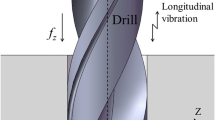Abstract
In this paper, a vibrational drilling tool using a magnetostrictive torsional transducer is designed and fabricated. The torsional transducer is a hollow cylinder, which is made up of “2 V permendur.” Passing an alternating current through the material creates a variable circular magnetic field and exciting a coaxial coil with a direct current generates a constant axial field in the material. According to the Wiedemann effect, the magnetic domains of the material rotate helically in the direction of the external field and cause a shear strain in the material. To utilize the maximum torque and amplitude of the transducer as well as to maintain the transducer’s resonance conditions, a wave transmitter is designed to connect the transducer to a drill bit. The dimensions of the vibrating tool are calculated theoretically and verified by the finite element software of COMSOL. Friction couplings are designed to connect the transducer, wave transmitter, and the drill bit. This torsional drilling tool is used for drilling of aluminum workpieces. The tests show that torsional vibrations reduce the required drilling torque by 60% in comparison to conventional drilling. In addition, usage of the torsional vibrations has the effect of the chip breaking, improving the accuracy of the hole size by 55.4%, and reducing the drilling surface roughness by the percent of 25.3% in comparison to conventional drilling.
Similar content being viewed by others
References
Wertheim R, Rotberg J, Ber A (1992) Influence of high-pressure flushing through the rake face of the cutting tool. CIRP Ann Manuf Technol 41(1):101–106
Usui E, Kikuchi K, Hoshi K (1964) The theory of plasticity applied to machining with cut-away tools. J Eng Ind 86(2):95
Short M, Graff K (2015) Using power ultrasonics in machine tools. Power Ultrason:439–507
Shamoto E, Suzuki N, Naoi Y (2002) Development of ultrasonic elliptical vibration controller for elliptical vibration cutting. CIRP Ann 51:327–330
Ma C, Shamoto E, Moriwaki T, Wang L (2004) Study of machining accuracy in ultrasonic elliptical vibration cutting. Int J Mach Tools Manuf 44(12–13):1305–1310
Hu H, Sun Y, Zu Z (2010) Simulation and experiment of cutting force in ultrasonic torsional vibration assisted micro-milling. 5th International Symposium on Advanced Optical Manufacturing and Testing Technologies: Design, Manufacturing, and Testing of Micro- and Nano-Optical Devices and Systems
Xiang D, Yang G, Ziang S, Wang Y, Qin Q (2014) Study on milling force of high volume fraction SiCp/Al composites with ultrasonic longitudinal and torsional vibration high speed milling. Adv Mater Res 910:114–117
Qu W, Wang K, Miller M, Huang Y, Chandra A (2000) Using vibration-assisted grinding to reduce subsurface damage. Precis Eng 24(4):329–337
Wang Y, Lin B, Wang S, Cao X (2014) Study on the system matching of ultrasonic vibration assisted grinding for hard and brittle materials processing. Int J Mach Tools Manuf 77:66–73
Molaie M, Akbari J, Movahhedy M (2016) Ultrasonic assisted grinding process with minimum quantity lubrication using oil-based nanofluids. J Clean Prod 129:212–222
Xu W, Lu X, Pan G, Lei Y, Luo J (2010 Apr 1) Ultrasonic flexural vibration assisted chemical mechanical polishing for sapphire substrate. Appl Surf Sci 256(12):3936–3940
Azarhoushang B, Akbari J (2007) Ultrasonic-assisted drilling of Inconel 738-LC. Int J Mach Tools Manuf 47(7–8):1027–1033
Baghlani V, Mehbudi P, Akbari J, Sohrabi M (2013) Ultrasonic assisted deep Drilling of Inconel 738LC Superalloy. Procedia CIRP 6:571–576
Kadivar M, Akbari J, Yousefi R, Rahi A, Nick M (2014) Investigating the effects of vibration method on ultrasonic-assisted drlling of Al/SiCp metal matrix composites. Robot Comput Integr Manuf 30(3):344–350
Yagishita H (2007) Effect of Ultrasonic Torsional Mode Vibration Cutting on Drilling in CFRP Laminates. Proceedings of ASPE Spring Tropical Technology. 92–97
Amini S, Soleimani M, Paktinat H, Lotfi M (2017) Effect of longitudinal− torsional vibration in ultrasonic-assisted drilling. Mater Manuf Process 32(6):616–622
Al-Budairi H, Lucas M, Harkness P (2013) A design approach for longitudinal–torsional ultrasonic transducers. Sensors Actuators A Phys 198:99–106
Karafi M, Hojjat Y, Sassani F, Ghodsi M (2013) A novel magnetostrictive torsional resonant transducer. Sensors Actuators A Phys 195:71–78
Wang L, Yuan FG (2008) Vibration energy harvesting by magnetostrictive material. Smart Mater Struct 17(4):045009
Karafi M, Hojjat Y, Sassani F (2013) A new hybrid longitudinal–torsional magnetostrictive ultrasonic transducer. Smart Mater Struct 22(6):065013
Chang SS, Bone GM (2009) Thrust force model for vibration-assisted drilling of aluminum 6061-T6. Int J Mach Tools Manuf 49(14):1070–1076
Pujana J, Rivero A, Celaya A, De Lacalle LL (2009) Analysis of ultrasonic-assisted drilling of Ti6Al4V. Int J Mach Tools Manuf 49(6):500–508
Wang J, Feng P, Zhang J, Zhang C, Pei Z (2016) Modeling the dependency of edge chipping size on the material properties and cutting force for rotary ultrasonic drilling of brittle materials. Int J Mach Tools Manuf 101:18–27
Geng D, Lu Z, Yao G, Liu J, Li Z, Zhang D (2017) Cutting temperature and resulting influence on machining performance in rotary ultrasonic elliptical machining of thick CFRP. Int J Mach Tools Manuf 123:160–170
Author information
Authors and Affiliations
Corresponding author
Rights and permissions
About this article
Cite this article
Karafi, M.R., Korivand, S. Design and fabrication of a novel vibration-assisted drilling tool using a torsional magnetostrictive transducer. Int J Adv Manuf Technol 102, 2095–2106 (2019). https://doi.org/10.1007/s00170-018-03274-w
Received:
Accepted:
Published:
Issue Date:
DOI: https://doi.org/10.1007/s00170-018-03274-w




